Beijing, China's national capital, is situated at the north edge of the North China Plain. Not far to its northwest is the vast Inner Mongolian Plateau and a hundred kilometers to the east is the Bohai Sea. Beijng is also flanked by the crawling Taihang Mountains to its west and the alluvial plain by the rivers of Yongding and Chaobai to its south. Located in the North Temperate Zone with a continental monsoon climate, Beijing enjoys and annual mean temperature of 11.8°C (53.24°F) and annual mean precipitation of 630 mm, which concentrates mainly in the summer. January is the coldest month with the monthly mean temperature of -4.7°C (23.54°F) while July the hottest month with a mean temperature of 26.1°C (78.98°F). Beijing's spring is relatively short, and people used to say that when the last day of the winter is gone, the summer is about to set in. Summer is usually hot with abundant rainfall. Autumn days are cool with clear sky and gentle breeze, making it the best season to travel. As winter is severe, outings naturally require heavy clothing. Climatically, Beijing's four seasons cater to different interests of tourists. You can travel at any time of the year as you like.

Beijing is a great city noted for the rich heritage of oriental history and culture. As early as three thousand years ago, a primitive tribal community started to take shape here. A tone had already come into being two thousand years ago. From 900 A.D. onward, Beijing served first as the secondary capital of the Liao Dynasty (916-1125) and then capitals of the Jin (1115-1234), Yuan (1271-1368), Ming (1368-1644) and Qing (1644-1919)Dynasties successively. Beijing was made the capital of the People's Republic of China which was founded on October 1, 1949.Beijing and its surrounding counties are known to have the best quality Miyun dates, Jingbai pears and Liangxiang chestnuts. King-size persimmon and especial the frozen ones are unique. Preserved fruits from of a part of Beijing's traditional speciality. The Beijing Duck is a fine breed, well-know for its delicate meat. Beijing also offers artefacts, jade and stone carvings, filigree and lacquer ware, jewellery and the watercolor wood block printing of Rongbaozhai.
1. The Imperial Palace and the Forbidden City
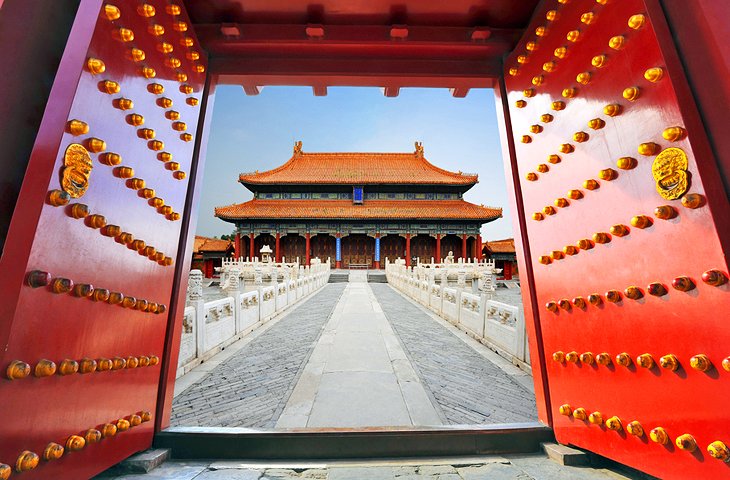
The Imperial Palace, also known as the Forbidden City, is China's most significant attraction and can trace its origins back to the Yuan Dynasty of the 13th century. Its immense size is the result of enlargements made during the Ming Dynasty between 1406 and 1420, after the capital was transferred here from Nanking. All told, this beautiful palace has been home to 24 Ming and Qing Emperors, earning its nickname of the Forbidden City due to the fact ordinary citizens weren't allowed access. The complex covers 720,000 square meters, all of it surrounded by a 10-meter-high wall with towers in the four corners and a 50-meter-wide moat, and is divided into an area used for ceremonial and administrative purposes, as well as the private quarters used by the Emperor and his concubines. Highlights include the Meridian Gate, built in 1420; the Golden River Bridges, a network of five richly decorated white marble bridges; the Hall of Preserving Harmony, which functioned as the Emperor's banquet hall; the Palace of Heavenly Purity, the largest hall in the Inner Court; and the Hall of Military Courage, a permanent residence and private audience hall for the emperors. Also of interest is the nearby Imperial College, founded in 1287 by Kublai Khan and only closed in 1900, and the impressive 35-meter-high Hall of Supreme Harmony, notable as the country's largest surviving wooden building and for its splendidly decorated gilded imperial throne. To many, many people, Beijing is an ancient capital city in the east. Forbidden City is the right place for you to start your Beijing tour by unveiling its mysterious face. Consisting of over 9,000 rooms and spread over 250 acres, this large palace complex was built between 1406 and 1420, but was burnt down, rebuilt, sacked and renovated countless times, so most of the architecture you can see today dates from the 18th century and on wards during the Qing Dynasty. Wear comfortable shoes as you have to walk a lot! I highly recommend going with a guide. It really is helpful to have a guide explain the stories behind the site and tell you about the important historical parts in the forbidden city. Or if you are non-group tourists, I suggest you rent multi lingual guide recorder either at Meridian Gate ( southern gate of Forbidden city ) or the Gate of Divine Prowess (Northern gate of Forbidden City) and return it when you finish your tour of Forbidden City. After you visit the Imperial Palace and go out of the Gate of Divine Prowess, you can enter into Jingshan Park, climb a bit and overlook the panorama of the Imperial Palace. In the evening, especially in summer, Forbidden City is brilliant. Colored lights from all directions lighten Meridian Gate, the Gate of Divine Prowess, turret, palace wall and other main palaces.
2. The Great Wall of China
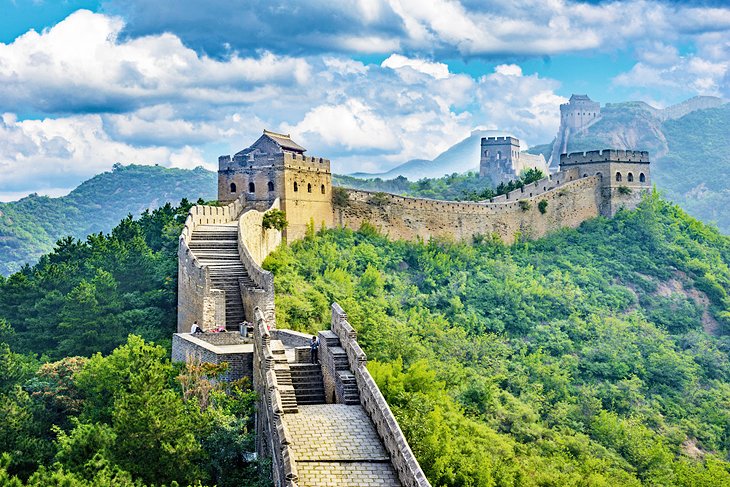
Beijing is only an hour away from what is undoubtedly one of the country's most famous historic structures: the Great Wall of China. Here at Badaling Pass, the first part of the Wall to be opened to tourists in the 1950s, you can enjoy a walk along an impressive section of the Great Wall dating from the 16th century and standing up to eight meters high. Along the way, you'll be able to enjoy numerous towers and parapets offering superb views over the surrounding dramatic scenery. While a hilly walk, you can in fact take a pleasant cable-car ride up to the wall. This much-visited section of the Great Wall can get busy, so if possible try to plan your trip for an early arrival, or consider signing up for a tour. The Great Wall of China at Badaling and Ming Tombs Day Tour offers great insight into the history and is an extremely easy way to visit this site. Another popular spot to experience the Great Wall is Mutianyu, parts of which date back to the 6th century. Rebuilt and expanded over the centuries, it is becoming increasingly popular for its magnificent views, which are particularly beautiful during spring and autumn. If you are in a rush, you can get the most out of your visit to Beijing by hiking one of the sections of the Great Wall. The Great Wall snaking across Beijing in its northern part is about 600 kilometers long. Along the total length of the Great Wall around Beijing, there are major eight sections including Badaling, Juyongguan, Huanghuacheng, Jiankou, Mutianyu, Gubeikou, Jinshanling, and Simatai. Most of the sections of Great Wall in Beijing are well-preserved and mainly the remains from the Ming Dynasty, an era of huge construction. For the climbing of the Great Wall, strong footwear is needed! In summer, please prepare for sunblock, sunglasses and water.
3. Tiananmen Square
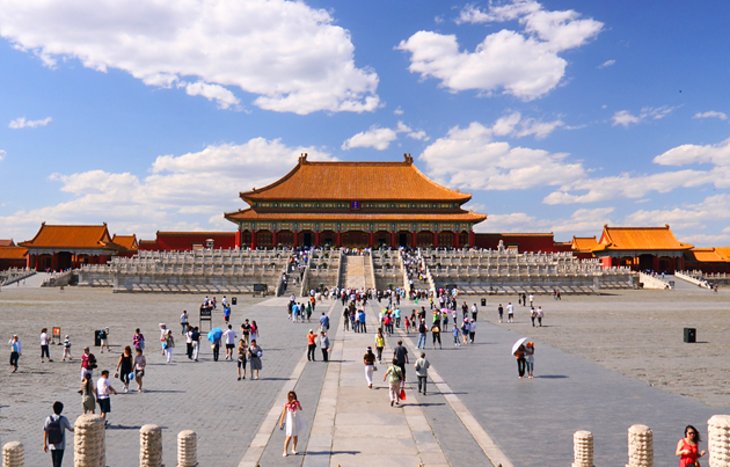
Tiananmen Square (the Square of Heavenly Peace) is the world's largest inner-city square, designed to hold a million people and built to celebrate the 10th anniversary of the Chinese Republic in 1958. Considered the center of communist China, the square's symbolic importance dates back to May 4th, 1919, when students demonstrated against the Chinese provisions of the Treaty of Versailles. Highlights include the Monument to the People's Heroes (Rénmín Yingxióng Jìniànbei), a 38-meter tall obelisk consisting of 17,000 pieces of granite and marble, and the splendid Tiananmen Gate - the Gate of Heavenly Peace - completed in 1417 and once the main entrance to the Imperial City. Another important gateway is Zhengyangmen, or Qianmen, the southernmost gate into Tiananmen Square. Tracing its roots back to the early 15th century and restored in the early 1900s, this imposing structure is considered one of the most important landmarks in the city. Other features of note are the Museum of the Chinese Revolution with its exhibits illustrating the various stages of the Chinese revolution from 1919 and the development of the Communist Party, and the Mausoleum of Mao Zedong, where the body of Mao rests in a crystal sarcophagus. What is the symbol of Beijing? There are various answers. But Tiananmen Square is definitely on the top list. Located in the heart of Beijing City, it is the site for massive parades and rallies, which is the largest square of this kind in the world. This was the site when in 1949, from a rostrum on Tiananmen (the Gate of Heavenly Peace), Chairman Mao proclaimed the establishment of the People's Republic of China. Tiananmen Square is surrounded by Tiananmen ( Gate of Heaven Peace ) on its north ; the Great Hall of the People on its west, the meeting place of national people's congress of the People's Republic of China; on the east of Tiananmen Square is the National Museum of China, and visiting the exhibition is like reading concise China General History; there is Monument to the People's Heroes and Chairman Mao's Mausoleum on the south. At sunrise and sunset the raising and lowering ceremony of the Chinese National Flag is well worth the watching. The precision of the young troops is very well performed. Go there about 30 minutes early to have a good seat. Spend the time to see the people (soldiers, tourists and locals) makes the square a true highlight for the first time visitors.
4. The Temple of Heaven
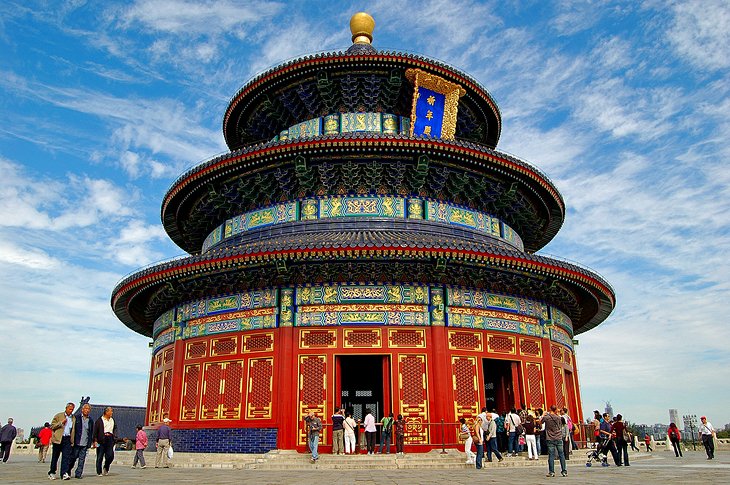
The Temple of Heaven (Tiantán) dates back to 1420 and incorporates a group of some of Beijing's most sacred buildings. Surrounded by lush vegetation, these lovely old temples and shrines are set out in two sections - one rectangular, the other semi-circular - which together symbolize heaven and earth. It was here that, on the day of the winter solstice, the emperor would ascend the Heavenly Altar in solemn ceremony to pray for a good harvest and offer sacrifices in the brightly decorated Hall of Prayer for Good Harvests (Qinian Dian). Built in 1420, in customary Chinese fashion of wood and entirely without nails, the hall sits on a three-tier marble terrace with balustrades and a roof covered with 50,000 blue glazed tiles (a marble plaque on the floor represents the dragon and the phoenix stone, symbols of the emperor). Another highlight is the Hall of the Vault of Heaven (Huangqiong Yu), erected in 1530 and boasting a blue-tiled conical roof (it was used to store the ceremonial plaques of Heaven and the Officials). Be sure to also visit the temple's Echo Wall, which echoes to even the quietest of voices, an effect exaggerated by three unusual echoing stones. I recommend Temple of Heaven as a real highlight of Beijing. It is located in the southern part of Beijing, and has been one of the most holy places for the whole country for more than five centuries. It used as a complex of sacrificial buildings for the Ming and Qing emperors, and is the largest one in Beijing among several royal altars to Heaven, Earth, the Sun, the Moon and other deities or symbolic forces of Nature. If you go to the Temple of Heaven in the early morning, you can see groups of people practicing all types of kung fu and taiji. Many people contentedly entertain each other with music,songs or quietly playing cards. You can also practice with them if you are so inclined. This is another good activity for the jet lagged. What makes the temple unique is the century-old trees - line upon line of Chinese cypress, Chinese juniper and scholar trees. Some of the cypresses are more than 600 years old. Dr Henry Kissinger, when he visited the temple, stated that while the USA could recreate the Temple of Heaven if it desired, it could not create the trees!
5. The Summer Palace
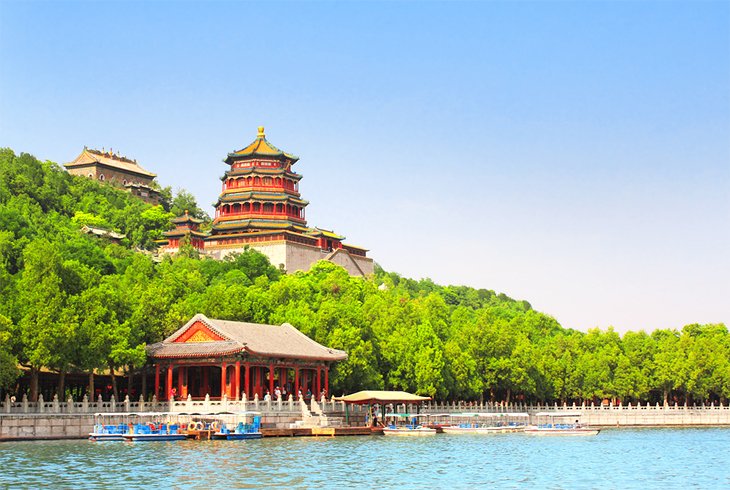
Located an easy 30 minutes journey by car, bus, or taxi from the center of Beijing, the city's Summer Palace (Yíhé Yuán) is a must-visit. Dating back to the 12th century and more than 700-acres in size, it's a picture-perfect setting, which certainly befits its royal status, boasting a large 700-year-old man-made lake and beautiful gardens. Often included on organized tours, top things to see are the western-styled "Marble Ship" (Shifang); the Hall of Well-being and Longevity (Renshou Dian), with its elaborate throne; the beautiful courtyard adjoining the Hall of Happiness and Longevity (Leshou Tang Hall); and the impressive 19th-century Great Theatre, where you can catch performances of traditional Chinese plays and music. One of the more popular things to do, if time permits, is to take a ride aboard the small pleasure craft (kids love the dragon-themed vessels) that ferry tourists to one of the palace's temples, as well as a stroll past the traditional riverside shops on Suzhou Market Street. As the largest royal garden in China, Beijing's Summer Palace is actually a park like imperial retreat spread out over 10 square miles. The Summer Palace in northwest suburban Beijing is the largest and most complete imperial garden existing in China. Once a summer retreat for emperors, this 290-acre park is still a retreat for the tourists, who can relax here or walk around ancient pavilions, mansions, temples, bridges and huge lake. Summer Palace mainly consists of Longevity Hill (Washoushan) and Kunming Lake. Much of it is covered by Kunming Lake. With masterly design and artistic architecture and integration the essence of Chinese garden arts, the Summer Palace has a title of "Imperial Garden Museum". It is an imperial garden most completely reserved with richest landscapes and concentrated buildings. The Summer Palace was added to the world cultural heritage list in 1998.






Lvl
ReplyDelete